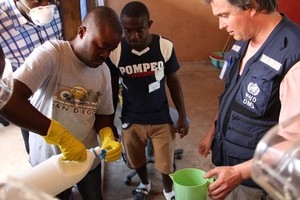
News Americas, GENEVA, Switzerland, Weds. Oct. 8, 2016: The World Health Organization is trying to quell concern when it comes to the transmission of the Ebola virus via coughing or sneezing.
The WHO on Tuesday, however, admitted that wet and bigger droplets from a heavily infected individuals, who have respiratory symptoms caused by other conditions or who vomits violently, could transmit the virus – over a short distance – to another nearby person.
“This could happen when virus-laden heavy droplets are directly propelled, by coughing or sneezing (which does not mean airborne transmission) onto the mucus membranes or skin with cuts or abrasions of another person,” the WHO said.
Saliva and tears may also carry some risk. However, the studies implicating these additional bodily fluids were extremely limited in sample size and the science is inconclusive.
In studies of saliva, the virus was found most frequently in patients at a severe stage of illness.
The whole live virus has never been isolated from sweat.
The Ebola virus is transmitted among humans through close and direct physical contact with infected bodily fluids, the most infectious being blood, feces and vomit.
The Ebola virus has also been detected in breast milk, urine and semen. In a convalescent male, the virus can persist in semen for at least 70 days; one study suggests persistence for more than 90 days.
The Ebola virus can also be transmitted indirectly, by contact with previously contaminated surfaces and objects. The risk of transmission from these surfaces is low and can be reduced even further by appropriate cleaning and disinfection procedures.
Ebola virus disease, however, is not an airborne infection.









